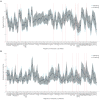Identifying Diurnal Variability of Brain Connectivity Patterns Using Graph Theory
- PMID: 33467070
- PMCID: PMC7830976
- DOI: 10.3390/brainsci11010111
Identifying Diurnal Variability of Brain Connectivity Patterns Using Graph Theory
Abstract
Significant differences exist in human brain functions affected by time of day and by people's diurnal preferences (chronotypes) that are rarely considered in brain studies. In the current study, using network neuroscience and resting-state functional MRI (rs-fMRI) data, we examined the effect of both time of day and the individual's chronotype on whole-brain network organization. In this regard, 62 participants (39 women; mean age: 23.97 ± 3.26 years; half morning- versus half evening-type) were scanned about 1 and 10 h after wake-up time for morning and evening sessions, respectively. We found evidence for a time-of-day effect on connectivity profiles but not for the effect of chronotype. Compared with the morning session, we found relatively higher small-worldness (an index that represents more efficient network organization) in the evening session, which suggests the dominance of sleep inertia over the circadian and homeostatic processes in the first hours after waking. Furthermore, local graph measures were changed, predominantly across the left hemisphere, in areas such as the precentral gyrus, putamen, inferior frontal gyrus (orbital part), inferior temporal gyrus, as well as the bilateral cerebellum. These findings show the variability of the functional neural network architecture during the day and improve our understanding of the role of time of day in resting-state functional networks.
Keywords: brain connectivity; chronotypes; circadian rhythm; graph theory; resting-state fMRI.
Conflict of interest statement
The authors declare no conflict of interest.
Figures



Similar articles
-
Diurnal variations of resting-state fMRI data: A graph-based analysis.Neuroimage. 2022 Aug 1;256:119246. doi: 10.1016/j.neuroimage.2022.119246. Epub 2022 Apr 25. Neuroimage. 2022. PMID: 35477020 Free PMC article.
-
Beyond the Low Frequency Fluctuations: Morning and Evening Differences in Human Brain.Front Hum Neurosci. 2019 Aug 27;13:288. doi: 10.3389/fnhum.2019.00288. eCollection 2019. Front Hum Neurosci. 2019. PMID: 31507393 Free PMC article.
-
Impact of sleep inertia on visual selective attention for rare targets and the influence of chronotype.J Sleep Res. 2017 Oct;26(5):551-558. doi: 10.1111/jsr.12525. Epub 2017 Apr 4. J Sleep Res. 2017. PMID: 28378363 Free PMC article.
-
Altered topological patterns of large-scale brain functional networks during passive hyperthermia.Brain Cogn. 2013 Oct;83(1):121-31. doi: 10.1016/j.bandc.2013.07.013. Epub 2013 Aug 17. Brain Cogn. 2013. PMID: 23959081
-
Application of Graph Theory for Identifying Connectivity Patterns in Human Brain Networks: A Systematic Review.Front Neurosci. 2019 Jun 6;13:585. doi: 10.3389/fnins.2019.00585. eCollection 2019. Front Neurosci. 2019. PMID: 31249501 Free PMC article.
Cited by
-
Circadian Rhythms Tied to Changes in Brain Morphology in a Densely Sampled Male.J Neurosci. 2024 Sep 18;44(38):e0573242024. doi: 10.1523/JNEUROSCI.0573-24.2024. J Neurosci. 2024. PMID: 39147588 Free PMC article.
-
Impact of biological rhythms on the importance hierarchy of constituents in time-dependent functional brain networks.Front Netw Physiol. 2023 Aug 29;3:1237004. doi: 10.3389/fnetp.2023.1237004. eCollection 2023. Front Netw Physiol. 2023. PMID: 37705698 Free PMC article.
-
Altered functional network topology and connectivity in female nurses with shift work sleep disorder.Front Syst Neurosci. 2025 Jul 15;19:1639981. doi: 10.3389/fnsys.2025.1639981. eCollection 2025. Front Syst Neurosci. 2025. PMID: 40735370 Free PMC article.
-
Classification of human chronotype based on fMRI network-based statistics.Front Neurosci. 2023 Jun 5;17:1147219. doi: 10.3389/fnins.2023.1147219. eCollection 2023. Front Neurosci. 2023. PMID: 37342462 Free PMC article.
-
Non-linear Functional Brain Co-activations in Short-Term Memory Distortion Tasks.Front Neurosci. 2021 Dec 3;15:778242. doi: 10.3389/fnins.2021.778242. eCollection 2021. Front Neurosci. 2021. PMID: 34924944 Free PMC article.
References
-
- Schmidt C., Peigneux P., Leclercq Y., Sterpenich V., Vandewalle G., Phillips C., Berthomier P., Berthomier C., Tinguely G., Gais S., et al. Circadian preference modulates the neural substrate of conflict processing across the day. PLoS ONE. 2012;7:e29658. doi: 10.1371/journal.pone.0029658. - DOI - PMC - PubMed
LinkOut - more resources
Full Text Sources
Other Literature Sources

